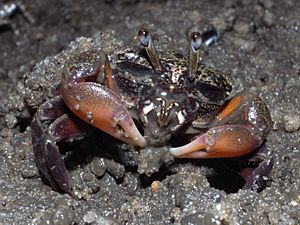Semaphore crab facts for kids
Quick facts for kids Heloecius cordiformis |
|
|---|---|
 |
|
| Scientific classification | |
| Kingdom: | |
| Phylum: | |
| Subphylum: | |
| Class: | |
| Order: | |
| Infraorder: | |
| Superfamily: |
Ocypodoidea
|
| Family: |
Heloeciidae
H. Milne-Edwards, 1852
|
| Genus: |
Heloecius
Dana, 1851
|
| Species: |
H. cordiformis
|
| Binomial name | |
| Heloecius cordiformis (H. Milne-Edwards, 1837)
|
|
| Synonyms | |
|
|
The Heloecius cordiformis, often called the semaphore crab, is a unique type of crab. It lives in mangrove swamps and mudflats along the eastern coast of Australia. Adult semaphore crabs are usually about 25 millimeters (1 inch) wide. Male crabs are generally larger than females. They also have bigger, more colorful claws.
Male semaphore crabs wave their claws to talk to other crabs. This special way of communicating is how they got their common name, "semaphore crab." These crabs can breathe both in the air and underwater. They eat tiny bits of food found in the mud when the tide is low. H. cordiformis is the only species in its group, called the Heloecius genus, and its family, Heloeciidae.
Contents
What Does the Semaphore Crab Look Like?
Adult semaphore crabs are about 25 millimeters (1 inch) wide. They have a dark purple, mottled shell, which is called a carapace. Their compound eyes are on long stalks, helping them see around their environment.
The claws of semaphore crabs are different between males and females. Male crabs' claws grow much larger as they get older. This means a big male crab will have very large claws compared to its body. Female crabs' claws grow at the same rate as their bodies, so they stay smaller.
The color of their claws also changes with their sex and size. Small crabs often have green claws. As they grow, their claws might turn orange or pink. The largest male crabs have purple claws. Female crabs with purple claws usually have smaller claws. The purple color helps the crabs stand out against the mudflats where they live.
Where Do Semaphore Crabs Live?
You can find H. cordiformis living along the coast from Brisbane in Queensland. Their habitat stretches south through New South Wales to Port Philip Bay in Victoria. They also live in the eastern parts of Tasmania.
How Semaphore Crabs Live and Behave
H. cordiformis lives in the intertidal zone of mangroves and estuaries. This is the area between high and low tide. They are often the most common crab species in these places. You can usually spot them among the roots of mangrove trees.
These crabs are amazing because they can breathe both in the air and in the water. When they are out of the water, they move their carapace up and down. This movement helps them breathe air without losing the water stored in their gill chambers, which are under their shell.
Semaphore crabs mainly eat by sifting through the sediment (mud and sand). They look for organic matter and detritus (dead bits of plants and animals) from the mangroves. They also have strong mandibles (mouthparts) that they use to eat bigger pieces of plants and animals. Both male and female crabs use their claws one after the other. While one claw brings food to their mouth, the other claw collects more material. Many different birds and fish hunt and eat H. cordiformis.
One of the most interesting behaviors of male semaphore crabs is how they communicate. They wave their bright, colorful claws to signal to other crabs. This waving motion looks a lot like semaphore signals, which is why they are called "semaphore crabs."
About the Semaphore Crab's Family Tree
The Heloecius cordiformis was first described a long time ago, in 1837. It was originally placed in a different crab family. Later, in 1851, it was moved to its own new group, called a genus, by a scientist named James Dwight Dana. Scientists later decided that Heloecius was very unique. Because of this, they created a whole new family just for this crab, called Heloeciidae. This means H. cordiformis is the only species in its genus and family.


